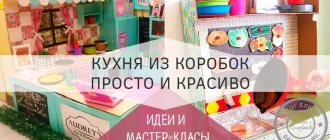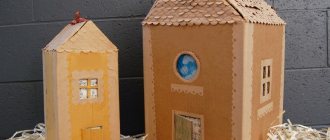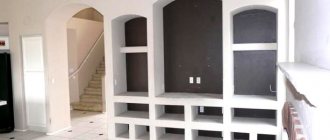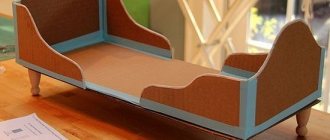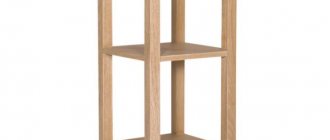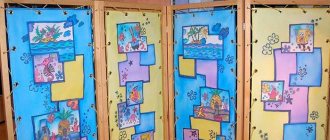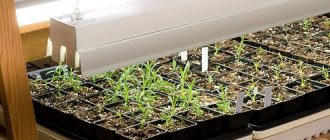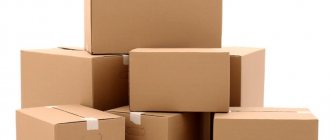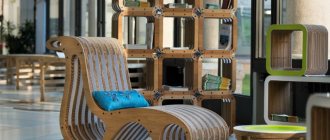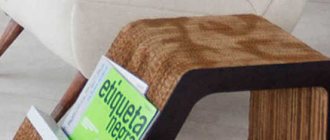- Preparing for work
- Assembling a cardboard shelf
- Master class on decor
Cardboard shelves are an indispensable furniture option if you can’t buy a new set.
A children's room or a summer house, a corridor or a kitchen - any room will be transformed if you place a convenient and practical shelf there. By doing it yourself, you can not only enjoy your skills, but also save some money. One of the cheapest and easiest materials to work with is cardboard. You can borrow it from any store, but to make a shelf it is better to go to a furniture store. The cardboard used there is quite durable and consists of 5 layers. Its thickness ranges from 5 to 10 mm - these are the optimal parameters for comfortable work.
In order to make any piece of furniture from cardboard with your own hands: a shelf, a bedside table, a decorative fireplace, you will need a number of tools and means to make the work easier. In addition to the main material, prepare:
- pencil, ruler, construction knife;
- a special surface for work, for example, a sheet of plywood;
- glue gun;
- glue "Moment";
- putty;
- wallpaper or self-adhesive for external decor.
Preparing for work
First you need to calculate the size of the shelf and the amount of material needed for it. The parameters will depend on its future location and your wishes. For our option, a project of 5 sections was chosen. The optimal height of the shelf is about 110 cm on the side with three sections, on the side with two - 69 cm. The width of the sections will be square, each side 30 cm.
The dimensions are known, you can start cutting the blanks. In total, you will need 2 blanks for each part, which are glued together:
- 4 parts with three sections;
- 8 pieces with two;
- 2 pieces from one.
By drawing out the details, you can calculate the size of the required sheet of cardboard. Do not forget to make all drawings in pencil, and make cuts with a construction knife. For convenient and high-quality work, use a thick, non-wooden ruler, as well as a good working surface that you won’t mind spoiling. She may be injured as a result of working with a knife.
After cutting, you will get separate cardboard shelves - parts that need to be assembled together. Before starting assembly, strengthen the structure with special stiffeners, which will add volume to the walls. To do this, you need strips of cardboard of arbitrary width (about 3-4 cm), which are placed around the perimeter of the part in a zigzag pattern.
Return to contents
Let's start making the rack
Here we will look at a rather original way of creating this type of furniture, which a beginner will surely quickly master. Despite the relatively high labor intensity, this option has many advantages:
- there is no need to look for large sheets of cardboard;
- the strength is much higher than with the classical assembly method;
- you can make furniture of a completely arbitrary configuration;
- no patterns will limit the flight of your imagination;
- You will need very little space to work (in ordinary cases you often have to take up an entire room).
As you can see in the photo, the vertical elements are assembled from small strips of cardboard, like a brick wall. Longitudinal parts are also glued together from 7-8 layers. All this allows us to make a very strong rack.
The work order is as follows:
- we create the base of the structure according to your dimensions, gluing cardboard in corrugated layers crosswise;
- press with a board and leave until dry;
- cut strips for vertical walls;
- we collect them in piles immediately at the base to the level of the next shelf;
- install the horizontal element and let the glue dry;
- then the procedure is repeated in the same sequence to the very top;
- when the rack as a whole is assembled, sand the edges as described earlier;
- cover them with craft paper;
- paint the furniture first with white acrylic paint, and then with a tinted composition.
Assembling a cardboard shelf
First, you need to glue all the parts and stiffeners with wood glue, since it does not deform the cardboard. Don't forget about the details placed around the perimeter. After careful gluing, place the blanks under the press. At home, they can be books or an overturned stool. When assembling, we connect all the parts in the cut out places, as if hooking them together.
Afterwards, you need to level the entire surface with putty, make the corners even, cover up holes or other manufacturing defects. This is necessary to obtain a flat surface, which will be easier to decorate later. Leave the shelves in a dry place for about 24 hours. After complete drying, make the product original, matching the style of your room.
You can make it out of cardboard with your own hands for a summer house or for a children's room.
In fact, I did not make this shelving unit from scratch, but on the basis of an old bedside table. However, if necessary, it can be made entirely from cardboard from absolute scratch.
In addition to the technique of making furniture from cardboard, I also used the technique of artificial aging and decoupage technique.
As promised, I’m sharing my experience step by step.
So, at the start I had this simple old bedside table from Soviet times:
The bedside table was completely covered with veneer and varnish, which adhered to it very firmly.
In such cases, it is recommended to remove the entire layer of decorative coating, but I must admit that this feat has never been possible for me. Therefore, I ignored this recommendation and simply laid all layers of paint and varnish on top. However, before painting, I cleaned and degreased the surface of the bedside table with white spirit, which can be purchased at any hardware or hardware store.
To make the rest of the rack, I used regular cardboard from regular cardboard boxes:
At first, like probably everyone else, I was tormented by the question, where will I get so many boxes? However, in practice, the mission turned out to be quite feasible.
As it turned out, cardboard boxes in stores are simply thrown away, so there are no obstacles to agreeing on their disposal. Especially good boxes are available in furniture and household appliance stores.
Well, of course, all my relatives and friends began to leave their empty cardboard boxes for me.
There are different technologies for making cardboard furniture walls of the required thickness and strength.
If the product is supposed to have thick walls, then it is best to fill the space between two sheets of cardboard with strips of cardboard of the appropriate width, gluing them perpendicular to the side sheets of cardboard.
However, in this case, I did not intend to make the walls of the rack too thick, so I used another method: simply glue several layers of cardboard together.
It must be said that cardboard comes in 3 and 5 layers. Three-layer cardboard has a wavy strip glued between two cardboard sheets, while five-layer cardboard has two wavy strips and three cardboard sheets.
Thus, if I came across sheets of five-layer cardboard, then I made four layers of cardboard for one part, and if I came across sheets of three-layer cardboard, then I made 6 such layers.
First, you need to cut out and cut out all the necessary parts of the future product in as many copies as will be required for further gluing of the layers in order to obtain the required thickness of each part.
In other words, I cut out six or four copies of each piece based on the thickness of the cardboard I had.
It is best to cut out parts with a sharp knife.
Each part needs to be signed so as not to get confused later, and it’s better to start working after all the parts have been cut out.
The next stage is gluing the parts. It is necessary to glue all layers of parts together to obtain the desired thickness of the product.
At the same time, I want to note that it is rarely possible to cut parts of the required size from a single piece of cardboard, but this is not scary. You can generally glue separate pieces of cardboard into the inner layers and try to make only the outer layers whole.
If this doesn’t work out, then that’s okay too. You can glue them from separate fragments and then prime the seams and cracks for further processing.
It is best to glue the layers with PVA glue.
It is best to lay the glued parts on the floor so that the cardboard does not sag from the glue and the parts are not deformed, and evenly press down on top with a weight and leave to dry for a day.
When I glued the layers of the side walls of the rack, I made only the outer layer solid, and glued the inner layers from separate parts, leaving grooves in place of future shelves:
When the side walls were ready, I drove the shelves into the grooves, securing them in the grooves with glue, and also, putting a weight on them, left them to dry for a day:
To strengthen the shelves in the grooves, it is best to use super PVA glue. He literally tightly glues the parts together:
When the shelves were firmly glued to the side walls, I glued the top of the shelf to the bedside table, also using super PVA glue, and left the structure to dry under a load for a day:
To ensure the strength of the shelves, it is advisable not to make them longer than 60 cm. But since my bedside table was 90 cm wide, I strengthened the shelves by gluing an internal partition into the middle of each:
In order to make the side cuts of the shelves and walls of the rack even and to disguise the cuts of the layers of cardboard inside them, I used strips of cardboard with factory folds.
All boxes have such folds, from toothpaste to cake boxes:
If you paste them over the side sections, they will look even and neat:
I covered all the places where I came across uneven cardboard with thin, even cardboard. Such cardboard can be found on binders, for example.
The fact is that before painting, it is recommended to cover the finished structure with craft paper (thick wrapping paper) or plain paper. I did so.
However, apparently because I use water-based acrylic paints, both craft and plain paper wrinkled and dried out in waves. In addition, even on smooth areas, its joints clearly showed through the paint, and the look turned out to be completely bad.
So next time I will try to avoid this stage, which I captured in the bottom photo. However, this time I did exactly this:
To fix this defect, I had to first paint the entire rack with nitro enamel to isolate the paper covering from subsequent painting.
I then covered the shelving with concrete contact. Concrete contact forms a rough coating and promotes good adhesion of the putty to the glossy surface.
Then I filled in all the unevenness with white gypsum putty and sanded it after drying with sandpaper.
I really liked the result that I got after using gypsum putty. I was unable to sand the surface perfectly evenly, and the resulting potholes created the effect of scratches and gouges that form on furniture during its natural aging.
The result is this:
I needed to get the effect of a cabinet that had been repeatedly painted with different colors, and which had become worn in different places over time.
In addition, I also wanted to get the effect of the Provence style, which is characterized by rough, even clumsy coloring of furniture pieces. This effect is created by painting furniture in two contrasting colors.
First a layer of dark color is applied, and then a layer of light color is applied on top of it, and between the strokes of light color the dark layer of “old” paint begins to show through.
I like to use gold or bronze paint as a dark layer. Firstly, they are suitable for any color of furniture, and secondly, they give the furniture a noble shimmer of antiquity.
So I painted the rack first with a layer of gold paint:
On it I put a layer of acrylic paint the color of baked milk so that a layer of gold paint was visible between the strokes:
Then I carefully painted the shelf one more time with light acrylic paint:
In order to consolidate the aging effect, you need to carefully go over all corners and folds with a sponge dipped in gold paint. Just before doing this, you need to make a few test touches with a sponge on paper or cardboard to remove excess paint.
And you will get aged corners like this:
These are the paints that I used: white acrylic enamel, which I tinted with acrylic paint, gold paint and aqualac:
After painting, I decoupaged the cornice and shelving doors.
At the very end, I installed new hinges and handles on the doors, and the rack is ready.
The photo is slightly distorted in color. In fact, my shelving unit has a very rich warm baked milk color.
When it comes to cardboard furniture, many people are usually interested in its durability. I deliberately put weights with a total weight of 10 kg on the shelf. As you can see, the shelf can withstand it completely calmly:
OK it's all over Now. I wish you all success in your work.
Self-assembled cardboard shelves will be useful in everyday life for those who have a lot of things, but it is difficult to store them compactly due to the lack of a closet with the proper number of shelves. Cardboard shelves can be arranged as you wish and placed in large cabinet niches. The details of making shelves from scrap materials are described in detail in the step-by-step instructions.
Materials
To work you will need to prepare:
- cardboard boxes of the same size;
- level;
- ruler;
- sharp knife;
- brushes;
- water;
- carpentry glue.
Step 1
. You need to carefully disassemble the prepared boxes. In the future, they should be cut to glue together into cardboard cubes. You can see the principle of assembling shelves in the following schematic drawings.
Step 2
. After cutting the boxes into component parts, apply the markings shown in the photo to each of them.
Step 3
. According to the markings, cut out the blanks to create a shelf.
Step 4
. Using glue and a brush, glue the cardboard blanks together. Coat the parts along the outer edge with glue and apply a little adhesive material in the central part of the elements. Please note that if the glue is too thick, it can be diluted a little with water.
Step 5
. After gluing each element, send the resulting material under the press. As a last resort, you can use a thick piece of plywood or foam plastic, on which you will need to stand with your feet. Let the glue set and glue the next layer of cardboard. A total of four to six such layers will be needed, which depends on the initial thickness of the cardboard boxes.
Step 6
. In places where the grooves for fastenings will be located, there is no need to lubricate the cardboard with glue. This will make it much easier for you to cut them out after gluing.
Furniture made from cardboard is an original, affordable way to transform unnecessary material into an unusual, charming thing. In appearance, it is almost no different from furniture bought in a store, but it will cost much less. If you have cardboard boxes, you will only have to purchase paint and glue. By following certain rules for processing the material, cardboard interior items will be very durable and will not bend under the load of objects.
Furniture made from cardboard is an original, affordable way to transform unnecessary material into an unusual, charming thing.
By following certain rules for processing the material, cardboard interior items will be very durable and will not bend under the load of objects.
On the eve of the first steps of work, you need to decide on the design and construction of a cardboard shelf; it can have a classic shape, be in the form of a rack or some kind of figure (elephant, bear, other animals or images) - it all depends on your imagination and abilities. The simplest option available to everyone is a classic or shelf-rack, since its creation requires a minimum of skills. They require a creative approach, in most cases the ability to draw, and require more time to create.
Elegant design - you design the item yourself, relying on personal preferences.
Note!
You should not use cardboard racks in places of high humidity (bathroom, street), as they will quickly lose their original appearance and become unusable. It is also necessary to protect furniture from fire, it is very flammable.
Practicality - you will only need to spend money on purchasing the necessary tools.
It is best to fasten cardboard products together with special plastic clips, rather than gluing them together. In this case, it can be easily disassembled.
Cardboard furniture can be disassembled and reassembled at any time, which is very convenient when moving or during renovations.
In order to increase strength, place a second, slightly smaller one in a box made of thick corrugated cardboard. Then the structure will acquire sufficient rigidity and will be able to withstand serious loads.
You don’t have to waste time searching for a practical, something you like that will fit perfectly into your interior.
Cardboard furniture does not contain harmful, toxic or other hazardous substances.
By showing your imagination and creativity to the fullest, you will create a unique interior masterpiece that will be admired by your family and guests at your home.
Is it possible to make furniture from cardboard?
You can make furniture out of cardboard. But not from everything. Thick packaging cardboard is suitable, from which boxes are made for televisions, refrigerators, countertops, prefabricated cabinets and other large household appliances and furniture. Thinner material can either be glued together in several layers, or reinforced with stiffeners made from accordion-folded strips of cardboard.
If you have cardboard boxes, you will only have to purchase paint and glue.
The most suitable packaging corrugated cardboard for our purposes is a sheet material consisting of five layers: three parallel sheets of ordinary cardboard, between which two corrugated sheets are glued with starch glue.
By following certain rules for processing the material, cardboard interior items will be very durable and will not bend under the load of objects.
Necessary materials and tools
- Cardboard. You should understand that the thicker the material, the stronger the furniture will be. There is an opinion that the dark color of cardboard indicates its high density and vice versa - light cardboard is thinner. However, do not rush to get rid of the thin material; it will be useful for gluing joints. Or glue thin cardboard together, thus obtaining thick cardboard. If you use this method, glue the waves of each subsequent layer perpendicular to the previous one.
- Scotch tape and glue. It is acceptable to use any type, but the best option would be Moment glue. Thanks to its properties, the cardboard does not get wet, all the necessary parts are quickly and securely fixed.
- Kraft paper is used to reinforce the edges of furniture; thin cardboard can be used instead.
- White paper or tracing paper. Stick it on the entire surface for easy decoration. Please note: before applying tracing paper or kraft paper, it must be torn, not cut.
- Stationery knife or jigsaw. Keep an eye on the sharpness of the tool; the accuracy and quality of cutting depends on it. Replace the cutting parts of the device more often. Using a jigsaw you can cut several layers of cardboard.
- To dry the glue faster, use a simple or hair dryer.
Durability - the service life of cardboard furniture will be long if it has not been exposed to dampness and was correctly processed during creation.
Shelves made of cardboard boxes
Advantages
The main advantages of cardboard furniture include the following:
- Low cost;
- Originality;
- Ease of use and movement;
- Possibility of creativity.
We have already talked about the cost of such furniture; you need to spend money on glue and paint.
Cardboard furniture is not glued together, but secured with special plastic clips. It is easy to disassemble if it is necessary to replace any individual part or make a rearrangement .
To summarize, we can say that such furniture is ideal for a children's room . Firstly , it is very cheap, so you don’t have to worry about it being damaged. Secondly , it can be done together with the child, thus developing his imagination. You can even make a baby chair and use it as a high chair.
Flaws
Disadvantages include lower strength of the material. But this does not mean that the furniture will be fragile and unreliable!
Of course, it is not intended for heavy loads, but you do n’t have to be afraid to put various accessories and books on a cardboard shelf, just like on any other bookshelf.
Guide to Making Cardboard Shelving
Idea No. 1. Shoe shelf
- You will need sheets of cardboard measuring 21x24 cm. Distribute them into 3 equal strips.
- Using a dull knife, you need to carefully push the strips so that they bend. Then you can glue the long sides of the sheet with colored tape. Next, make triangular oblong shapes from the sheets, secure them with tape.
- Thus, make the number of triangles you need. To fix such shelves, you need to glue the resulting triangles to whole sheets of cardboard with double-sided tape or glue. You choose the required number of rows and sections at your discretion.
- Instead of triangular sections, you can create oval ones by connecting them together as well. Calculate the required diameter for your shoes and glue the rectangular strips of cardboard so that they form an ellipse.
On the eve of the first steps of work, it is necessary to decide on the design and construction of the cardboard shelf; it can have a classic shape, be in the form of a rack or some kind of figure.
The dimensions of the desired shelf and the amount of materials depend on personal wishes.
Idea No. 2. Hanging shoe rack
- You will need several large sheets of cardboard. Based on the size of your shoes, draw the cardboard into equal rectangles and cut them out.
- Divide each of the rectangles into three parts and bend them. Bend the two sides obliquely and connect them together so that you get a pocket that is wide at the top and narrow at the bottom.
- The bottom of each pocket must be attached with glue or double-sided tape to the top of the previous one from the inside, leaving space for shoes.
- Such a shelf can be mounted on the door itself or on the wall near it - in any case, such an original solution takes up little space.
The simplest option available to everyone is a classic or shelf-rack, since its creation requires a minimum of skills.
Idea No. 3. Bookshelf
- The dimensions of the desired shelf and the amount of materials depend on personal wishes. The best option is a rack with five sections, 110 centimeters high on the side of three sections and 69 centimeters high on two sections. Each section will be square, the sides will measure 30 centimeters.
- For each part you need two blanks that need to be glued together. In total you should get 4 with three, 8 with two, 2 parts with one section.
- Make all drawings with a ruler, cut parts using a knife and a thick ruler. If you will be cutting on the floor or on a table, first ensure that the surfaces are protected from cuts.
- Before starting assembly, create additional stiffening ribs for the structure; they will create additional volume and strength for the walls. To do this, make strips of cardboard approximately 4 centimeters wide, glue them sideways in a wavy pattern around the perimeter of one part of the part, then attach the second part.
- Next, for good fixation, the workpiece needs to be put under the press. You can use stacks of heavy books or a stool as a press.
- After carefully gluing the parts, you can begin assembling the shelf; to do this, connect all the parts together in the cut out places, interlocking them with each other. Then level the surface with putty, smooth out the corners and hide all other imperfections. It will take a day for the shelves to dry completely. This will allow you to get a perfectly flat surface for easier decoration.
- Design the finished shelving to your liking.
Unusual, figured shelves are more difficult to manufacture.
Sandpaper is useful for sanding cuts.
Materials for making shelves
Specialists and home craftsmen who love to do everything with their own hands are not limited in anything in terms of the choice of raw materials. For homemade flower shelves, you can use whatever you have on hand, such as pipe scraps, pallets, old suitcases and other items.
However, in the production of high-quality furniture the following are used:
- wood..
- MDF, chipboard, chipboard, plywood.
- metal.
- cup.
- plastic.
Plastic shelf
It sounds like a play on words, but the window sill flower shelf is made from... window sill. It can be found in finished form in hardware stores or purchased from plastic window manufacturers. In addition to the plastic napkin, you will need:
- nickel-plated pipes;
- flanges;
- brackets;
- work tool.
- The window sill is cut lengthwise into three pieces of equal size.
- In addition, three holes are drilled in each part into which the rack pipes will be inserted.
- They are located according to the following pattern: 2 holes along the edges of the back line and 1 in the center of the front line. The result should be a support triangle.
- The next step in creating a DIY flower shelf is to cut the pipes.
- The three parts are the same length. We assemble the structure and fix the elements with flanges and screws. For greater reliability, the two rear pipes are secured to the wall with brackets.
Plastic shelf options are very practical. They are easy to care for, and they are not afraid of water, which is very important in the case of flowers.
Wooden flower shelves
Wood is one of the most reliable building materials.
Properly assembled and secured wooden shelves or racks will be suitable for any number of plants, regardless of their size. When choosing hanging wooden shelves, you can limit yourself to the simplest option. To do this, take wood of the required length, coat it with varnish or varnish and attach it to the wall with metal corners.
By replacing clasps with leather straps, you get a creative approach to design that adds personality.
- Wooden floor stands are made for plants in large flowerpots. They can withstand a lot of weight, which allows you to combine different colors.
- A corner shelf is easily assembled from scraps, even of different lengths. Flowering bushes with their bright colors diversify the boring life of corners.
- For those who like unusual options, we offer wooden shelves that combine different materials.
- The method of attaching wooden shelves or racks is the same as in the plywood version.
Glass shelf
Although the main location of such shelves is considered to be a window, no one bothers to move them to the walls and even the floor. The texture of glass will allow plants to receive a sufficient portion of light everywhere. Such designs will become a real highlight of the interior if they are equipped with original lighting.
But let's return to the window option. How to assemble such a flower shelf with your own hands?
You need to cut three to five blanks from glass, and also prepare two wooden slats. Be careful, any glass will not work. It must be thick, 5 mm and hardened, otherwise the weight of the pots will not support it.
To secure the shelves, you will need to cut grooves into the guides. Make them deep enough to support the main load-bearing elements.
shelves made of MDF, chipboard
There are many design options for corner flower placement. Ergonomic and functional handmade shelves will allow you to effectively use the space of the room. Structures of any size can be made from wood materials.
The easiest way is to make a multi-story shelf that tapers at the top, allowing you to accommodate different types of plants. It is necessary to cut suitable surface blanks from chipboard and MDF sheets. Then drill holes that match the diameter of the center axis.
We put all the parts one by one and fasten them with flanges. We install it in a corner at a certain height and fix it with brackets. The vertical decor of indoor plants can be painted or varnished.
Forged metal shelf
Finely wrought ironwork creates a classic, luxurious ambiance. Such shelves can be made only of metal or combined with wood or glass. The results are very impressive interior details.
Most of these shelves are made to be floor-mounted due to their heavy weight. Forged shelves for flowers on the wall are made of small and medium sizes; special fastenings with increased strength are installed for them. The walls must also be strong enough to support this weight.
Combined flower shelves
The most popular combination is the duet of metal and wood. The wooden base, supported by a beautifully welded or forged metal frame, is ideal for modern interior solutions as a wall or floor flower shelf.
To create such an accessory, you will need metalworking skills, so assembling it yourself will be difficult. It is better to order the model you are interested in from a specialist.
But this is not the only option for combining materials. Wood can be integrated into leather, rope, glass. Glass, in turn, makes an excellent pair with chromed metal, and the latter interacts well with bright plastic. You can check out standard and crazy combination designs on the Internet.
Shelves made of plastic pipes
Cheap and easy-to-use PVC material makes original flower stands. For anything else you will need several meters of pipes, tees, plugs and wood siding. The material can be ordered for cutting directly in the store, depending on the size and number of design parts.
We adjust all the details of the future shelf according to the drawing, connect and glue them together. For beauty, we put spikes on the legs. We make holes in wooden blanks and fasten them to plastic pipes. 2-3 levels are enough, since flexible material cannot withstand heavy loads.
Which material is better to choose
Metal structures are very durable and can withstand a lot of weight. This setup feels expensive and rugged. But it requires special care and special treatment, otherwise corrosion may occur and the flower shelves will deteriorate.
It is almost impossible to build a plastic cabinet yourself; it is ordered in stores or on the Internet. They are unpretentious and very easy to use. Sections can be chosen in any shade. Since plastic is very flexible, crafts made from it can come in different shapes and sizes. They are easy to clean and move as they are lightweight.
The manufacture of wood products is very popular. But the furniture is inconvenient to use. When watering plants, water often gets on the surface of the stand, the board and can rot and swell. If you decide to build a wooden shelf, it must be carefully processed, and the surface must be well coated with a special varnish.
Glass structures have a simple and sophisticated look, but to create them you need to have experience working with glass. They need special care. And such fastenings cannot be given much weight. They work well if you need to place one or two pots.
Combination sections include several components. Usually it is wood with metal or glass with metal. The crafts have an unusual appearance. They can support a lot of weight due to the combination of substances and are not too extravagant to clean.
The final stage is decoration
You can decorate cardboard products with your own hands from any materials, it all depends on your wishes and fantasies - there are many options. The simplest ones are wallpaper, film, paint.
Cover the entire surface of the product with old pieces of wallpaper, or just the inside, and paint the outside in your favorite color. You can completely paint the shelves, or use stencils or create unique patterns or designs yourself.
The simplest way is to use self-adhesive film. It has an attractive appearance, quickly and reliably sticks to the surface, unlike wallpaper, it can be washed. If defects appear on the film or you want to change the design, just purchase and stick another one.
Unusual, figured shelves are more difficult to manufacture.
Master class: decorating a product using pages of glossy magazines
You will need:
- any paper for the base, newspapers can be used;
- glossy magazines;
- universal or PVA glue;
- acrylic lacquer.
It is also necessary to protect furniture from fire, it is very flammable.
Pencil, tape measure for measuring and drawing details.
Cut magazine pages into strips 1-2 centimeters wide, and twist them into tubes using a thin pencil or knitting needle. Glue the resulting glossy straws in a row onto the paper used as a basis. Then cut the canvas from the tubes into a suitable width corresponding to the location of the decoration and place it on glue. When the surface is dry, coat it with acrylic varnish.
The process is very long and tedious, but the effect is amazing.
It is best to fasten cardboard products together with special plastic clips, rather than gluing them together.
Modern flower stands
Recently, popular interiors are increasingly looking for geometrically simple and laconic forms. And we like them for their simplicity. But not everyone is ready to give up plants. The good news is that even laconic techno styles can adapt to plants.
Their form should also be concise and strict. And also a floor stand. Look at yourself. Stands can be made of metal and wood in any style. Also for high-tech or minimalism style. And it’s not even worth talking about loft or rustic. There are many interesting ideas.
To get the maximum effect, you need to choose the right plant shape.
Master class: surface decoupage
You will need:
- napkins with drawings;
- acrylic paints, acrylic varnish and brushes;
- scissors;
- iron.
In order to increase strength, place a second, slightly smaller one in a box made of thick corrugated cardboard.
Materials for decorating the finished product - paints, wallpaper, fabric and everything else your imagination desires.
Cover the surface of the rack with several layers of paint, let each layer dry, then apply another. Do not dry the very last layer completely; it should remain sticky. Remove the top layer from the napkin, run an iron over it and place it on the surface of the product. Place a clean sheet of paper on top of the napkin and iron it with an iron heated at low power.
Instead of paint, you can use wallpaper or fabric.
The napkin should completely stick to the surface, but if not, add a little paint under it with a brush and let it dry. Do not rush to the next step; the decoupage must dry thoroughly, otherwise the design will be deformed.
You should understand that the thicker the material, the stronger the furniture will be.
Please note: before applying tracing paper or kraft paper, it must be torn, not cut.
When the surface is completely dry, coat it with acrylic varnish.
However, do not rush to get rid of the thin material; it will be useful for gluing joints.
By showing your imagination and creativity to the fullest, you will create a unique interior masterpiece that will be admired by your family and guests at your home. Don’t be afraid to experiment, keep up with the times, because cardboard furniture is not only affordable, but also an original option for creating comfort and a unique atmosphere.
When buying a refrigerator, TV or other household appliances for your home, do not rush to throw away the cardboard packaging. With just a little effort and time, you can turn boxes into beautiful, functional and original furniture. For example, make a rack for storing shoes, shelves for books or a laptop stand.
What materials and tools will be useful in your work?
To make a rack or shelf from cardboard you will need:
- The main material is cardboard. It is best to take a dense one, the strength of the furniture will depend on this. It is believed that the denser the cardboard, the darker it is. However, thin sheets should not be thrown away either. They can be used for gluing joints.
- Any glue will do, but it’s better to use Moment. It doesn't make the paper wet.
- A stationery knife - the sharper it is, the more accurate the cutting will be.
- Sharp scissors.
- Dull knife.
- Roulette.
- Sandpaper.
- Kraft paper.
- Pencil, eraser.
- Dye.
- Remains of wallpaper.
- Colored tape.
Master class No. 1
We recommend starting work by making a shelving unit yourself from cardboard. By strictly following the instructions, even a novice master can cope with the task.
- Divide sheets of cardboard measuring 21x24 cm into three even parts. Press the joints with a dull knife (the sheets should bend freely).
- Cover the long sides of the sheet with colored tape.
- Fold the sheets into triangles and secure with tape. You can make any number of triangles, depending on how many pairs of shoes you plan to store in the shelf.
- Assemble the rack. To do this, simply glue the triangles together. Place a flat sheet of cardboard on top. It will serve as a stand for high boots.
Master class No. 2
From sheets of cardboard you can make not only a shoe rack, but also hanging shelves. They will be a real find for owners of apartments with a small hallway, in which every centimeter of space counts.
How to make cardboard shelves with your own hands:
- Divide two large sheets of cardboard into rectangles (the size of your shoes) and cut them.
- Roll each rectangle into a pocket and secure with tape.
- Insert the pockets into each other, leaving space between them for shoes. Secure with tape.
The stages of work are clearly presented in the photo below.
- Attach the structure to the door. A functional and inexpensive rack is ready. If you wish, you can cover it with the remnants of old wallpaper or paint it with paint.
Flower shelf models
Today there are countless decorative elements that have practical significance in family life. We have compiled a list of existing models:
- Wall shelves. These options are used for arranging small flower pots. They take up little space, but require mandatory reinforcement on the wall.
- Floor models. Comfortable, original, varied in shape. Sufficiently sustainable home accessories.
- Corner shelves. This is the most profitable option in terms of saving living space. The model fits well in any corner and fills voids, if any.
- Suspension options. Some designers affectionately call this model a “swing”. On a similar shelf, you can place pots with intertwined plants or use trellises to place the pots.
Wall shelf
A small hanging shelf can be made from any sheet material or wide board. Consider the manufacture of chipboard as the most difficult material to work with.
The structure will consist of such details as:
- the base that will be adjacent to the wall;
- the shelves themselves, the number of which can be any;
- shelf in the form of right triangles with a straight or figured hypotenuse.
First, as with any model, a product diagram is drawn up to determine the size and quantity of material.
Then all the elements are cut out of chipboard using a jigsaw. Marks are made on the base for attaching shelves and supports. Holes for self-tapping screws are drilled along the marking lines. The parts are first glued to the base with universal glue, and then screwed to the ends on the back side of the base.
After the glue has set, the ends of the chipboard and the seams are puttied on the wood with putty. This is a great alternative to edges that can be difficult to secure on curved cuts, especially if they are not very sharp. All irregularities can be easily removed with putty.
When the putty has dried, all surfaces are sanded with fine sandpaper or an abrasive mesh and painted in the chosen color.
So, without much effort and professional furniture making skills, you can make a useful and beautiful thing for your home in just a few hours. We do exactly what you need in terms of functionality and decorativeness.
Floor stands
Flower stands can be fixed or mobile. Furniture wheels are attached to the base or furniture uprights. Low movable stands are useful for large flowers. The plant is easier to care for and easier to clean.
There are very low ones - for plants above a meter there are two tiers - for those that have not yet grown to a meter. In any case, this type of support is convenient for large plants. This type is also sometimes called a flower stand. Low floor stand on wheels - for tall or massive plants
There are also tall mobile bookcases or flower racks. At least four wheels, but five is better. Not because the weight can be heavy, but because moving a tall structure on five wheels reduces the likelihood of it tipping over. In any model, regardless of height, it is more convenient to turn the wheels.
Mobile racks are convenient: you don’t need to carry one pan at a time. Ride together
Hanging
Now it’s worth talking about light-loving plants that need to be installed closer to the window or even on the window. Of course, we will not talk about flowers, but about flower shelves. Of course, your desire to place flowers on the window may be caused not only by the plant’s love of light, but also by the growth structure of its shoots. They can be, for example, smooth or curly.
In this case, it is better to think about how to place these flowers higher. How to make shelves for flowers in this case? For this you can use different materials.
You can also place hanging potted plants in the window. To do this we only need a few 8x60 hook anchors.
- Use a hole punch to make a hole in the top of the window.
- Insert the anchor hook and screw it clockwise until it stops.
- We tie the ropes to the vases. It's better if it's regular fishing line. It's not that noticeable and quite strong. However, there is no limit to imagination.
Anchor bolt with hook
The anchor mechanism is designed in such a way that after screwing in, its spacer part expands and thus fits tightly to the concrete.
Corner flower shelves
You can save space by using a corner shelf. These products are mounted and mounted on the floor, placed on internal or external corners. They are made from any material.
These can be compositions of several separate shelves or real spacious shelves. The assembly and fastening of such structures depends on their types and materials.
Shelves for flowers and seedlings with lighting
Shelves with lighting for placing plants are made on large supports, of sufficient height for the free dispersion of artificial light. Traditional materials - wood, plastic, metal. Everyone chooses the most acceptable manufacturing option for themselves. The main thing is that the shelf lasts a long time, is practical and reliable.
A wooden product can be made from lattice-type timber. The bulky and heavy structure is installed on the floor and consists of several levels. For the rapid growth of flowers and seedlings in the winter-spring period and rapid growth of mass, it is necessary to install additional lighting. The following types of lamps are suitable for this:
- VEL. The diode circuit is assembled from a selection of light bulbs. Elements of the red and blue spectrum are suitable. They are placed one by one on the base and fixed with a special paste. They then lead to the driver and turn on the electrical outlet and switch.
- Fluorescent lamps. The devices have a fixed length, which must be taken into account when installing the backlight on a stand. The wire is carefully distributed along the previous shelf level and fixed with 2 lamps with a gap of 1.5 cm.
- Sodium gas discharge lamps. The lamps are screwed to the base using wire or metal tape. For their correct operation, you will also need to install an adjustment device.
- Phytolapma. Compact and economical lamps can be placed at any distance from the seedlings. Single elements with a large radius of light dispersion are located in the center, linear elements are installed on a special stand.
Master class No. 3
Today, almost everyone in the house has a laptop. In order not to store the gadget on the table, you can make a stand for it from cardboard. You will need the following in your work:
- thick cardboard,
- yardstick,
- several sheets of thin paper for a stencil,
- long ruler
- pencil,
- scissors,
- sharp stationery knife.
Having prepared the necessary tools and materials, begin making the rack.
- First of all, make a layout of the promenade. Take a sheet of paper and spread it on a flat surface. Measure the width of the laptop with a tape measure. Mark exactly half of the resulting value on paper and draw a line. This will be 1/2 of the base of the leg.
- From the ends of the drawn line, measure up 4 and 7 cm, connect. You will end up with a rectangle.
- Visually divide the figure into three parts. The first is a straight line at a distance of 4 cm. The second is a curved line drawn to the 7 cm line (angle 45 degrees). The third part is a line from the right end of the segment to the 7 cm line at an angle of 45 degrees. The layout of the leg is clearly shown in the figure below.
- Let's start making the shelf legs. In the previous photo this is part No. 2. Transfer the parameters from the photo to your template. Separately, stop at drawing the clove, which will later keep your laptop from falling. In height, it should be at least a third of the thickness of the gadget. The slot in the leg for fastening the parts should not be in the middle, but at a distance of 1/3 from the edge, about 3 cm in height, 3–5 mm in width.
- Cut out the resulting paper templates.
- Let's make a leg. To do this, attach the paper template to the cardboard and carefully trace it with a pencil. Flip the template over to the other side and trace again. In the end, you will end up with one symmetrical piece. Cut it out with a utility knife.
- Let's make the legs. Attach the paper template of the second part to the cardboard, trace, cut. The planned model of the rack assumes the presence of two legs. Therefore, make the second leg in the same way as the first. The main thing is that they turn out the same.
- We combine the cardboard parts along the slots and secure them with glue.
You will get such a neat rack.
Required Tools
To collect the configuration you will need the following tools:
- screwdriver;
- building level;
- electric drill;
- saw;
- pencil for marking;
- hammer;
- screwdriver;
- roulette;
- manage.
The choice of fasteners will depend on the raw materials of the future configuration. The heavier the raw material, the stronger the fastener. If you are planning to install a metal wall flower shelf, you will need to use a welding machine to attach it.
Otherwise, there is a chance that the stand will fall down soon.
Master class: plywood shelf
Making a shelf out of plywood is not difficult; first you need to prepare a suitable sketch.
- Plywood is easy to work with, you can cut out many interesting shapes, so the shelf will turn out unique and original.
- The sketch must be transferred to a sheet of plywood. It should be remembered that such a shelf will not withstand heavy loads, so you should not load it with flowers and overload it.
- To cut out figures, it is better to take a regular or electric jigsaw, after which you need to sand the cut edges of the saw with sandpaper and apply a special impregnation.
- The last stage is applying paint, which will allow the plywood shelf to become more resistant to damage and moisture.
The finished shelf can be decorated however you like, just use your imagination and prepare the necessary furniture.
Master class: shelf made of furniture panels and bars
Cutouts from glued furniture panels can be found in furniture workshops and bought for pennies. After all, shelves require very small parts that are difficult to find for other purposes. But you can also buy a sheet of the appropriate size.
This material is practically no different in appearance and characteristics from solid wood, it is just as easy to work with, and also requires a protective finish to increase moisture resistance. A neighborhood with which it is inevitable to put living plants on shelves.
Step 1. Decide on the number and shape of shelves, draw their outlines with a pencil on the cabinet panel.
Step 2: On the bad side, cover the outline with masking tape or masking tape to prevent chipping when cutting.
Step 3. Cut out the pieces with a puzzle.
Step 4. We fix the parts on the table with clamps and process their edges with a milling machine, rounding them or giving them a shaped shape.
Step 5. Remove all small irregularities and defects by sanding. To avoid the formation of abrasive scratches on the surface, sanding should be carried out along the grain of the wood.
Step 6. We also process the rods for the legs with a router, round the corners and smooth them until a smooth surface is obtained without scratches or burrs. If there is a desire and opportunity, they can get a curly shape. Otherwise, normal processing is sufficient. Also, instead of beams, you can use ready-made balustrades for stairs and railings.
Step 7: Flip the bottom shelf over, place the legs evenly on it, and trace each one at the base with a pencil. Then, in the center of the drawn square, we make a hole with a thin drill so that you can see where to screw in the self-tapping screw from the front side.
Step 8. Coat the ends of the legs with glue, put them in place according to the marks and fasten them with self-tapping screws using a screwdriver or screwdriver.
Step 9. Determine the position and height of the second shelf. It slides to the side relative to the bottom, so two legs of different lengths are needed: one on the floor and the other on the top of the bottom shelf. We calculate these dimensions, cut out the bars of the required length and fix them according to the already known pattern.
Step 10. Attach the third tier, one of the legs of which rests on the bottom shelf, and the other on the second.
Step 11. We coat the finished structure with varnish or varnish or impregnate it with a protective impregnation in two or three layers.
Master class: plastic shelf
Answering the question of how to make shelves for flowers with your own hands, you can try to make a plastic shelf, which is very convenient to use. The material used is a plastic window sill, which can be ordered separately.
Before this, you need to decide what the size of the shelf will be.
- You need to drill holes in the window sill for the legs, two on the sides and one in the center.
- A shelf is placed on the legs and all additional elements are attached.
- The most ideal place for such a shelf is a window, where it will look most appropriate.
- If you wish, you can use any plastic, you can even take an old plastic basin and cut out a shelf.
It can be mounted on the wall or hung, plastic shelves can be freely installed outside, they are not afraid of sudden temperature changes and precipitation.
How to make furniture durable?
Many people fear that shelves made of cardboard will not be strong enough, and deprive themselves of the pleasure of having such original and useful interior items in their home. In vain! The following tips will help you make furniture out of cardboard with your own hands, which will not be inferior in strength to those made from other common materials.
- Open the finished pieces of furniture with parquet varnish.
- Give preference to symmetrical parts; they are stronger than irregularly shaped elements.
- The more cross parts a product has, the more stable it is.
- Use dark cardboard in your work; it is stronger than light cardboard.
Another trick will help give the furniture more density. When making all furniture elements, use two layers of cardboard, one with horizontal waves, the other with vertical ones.
You can make many original and useful interior items from cardboard. And you won’t have to spend extra money on this. Almost everything you might need for work is in everyone's home.
Pros and cons of cardboard shelves
Like products made from any material, cardboard shelves have advantages and disadvantages. Let's start with the pros:
- Individual design, limited only by your imagination. No matter what kind of bookcase you make, no one has exactly the same one.
- Saving. Minimum investment.
- Easy to disassemble, assemble and transport (especially when fastened not with glue, but with plastic clips).
- Environmentally friendly, safe for health. The material does not contain toxic substances and does not cause allergies.
And, of course, the main plus is the satisfaction of doing it yourself. Not a single thing bought in a store can give you so many positive emotions.
In appearance, it is almost no different from furniture bought in a store, but it will cost much less.
There are also disadvantages:
- Insufficient fire resistance. Keep away from heating devices, heating pipes and open flames!
- Sensitivity to moisture. You cannot place furniture made from cardboard boxes in the garden, on the open veranda, in the bathroom or in the kitchen.
- Less strength than more traditional materials.
Cardboard furniture can be disassembled and reassembled at any time, which is very convenient when moving or during renovations.
Important! Cardboard structures are resistant to water and high temperatures. It is highly not recommended to place them in places with high humidity and near heating devices and open fire.
